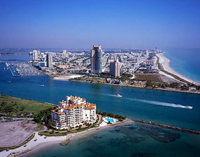Unemployment in Florida – A Case Study
17 August 2012

Florida has the world going for it: A warm climate that makes it a popular retirement destination for “snowbirds” from the northeast, beautiful, sandy beaches, an abundance of beautiful women, and Burn Notice, filmed in Miami and Fort Lauderdale, that serves as a weekly commercial for the Florida Tourist Commission. Furthermore, it has no state income tax, and among the country’s most favorable asset protection laws, providing nearly unlimited protection for home equity, life insurance and annuities against the claims of creditors and bankruptcy.
All these things should attract capital by the metric ton. And they do. But unemployment in Florida remains stubbornly high. It reached 9.9 percent last December, but dropped to 8.6 percent in May. Not because of any secular improvement in the job picture, but because so many people dropped out of the workforce entirely. Those people aren’t included in the usual unemployment numbers. Almost 70 percent of the ostensible decline in unemployment was because of people leaving the work force, rather than through true job growth.
According to a recent report, if the labor participation had remained constant between December of 2011 and May 2012, the unemployment rate would have been 9.5 percent.
Even so, despite Florida’s many advantages, the unemployment rate is still higher than the national average of 8.2 percent – and occasionally spikes much higher.
Why is Florida having a hard time? Look to Florida’s history.
Florida has long been a kind of a commercial “wild wild west” located in the East. The state’s beaches and swamps have hosted a notorious boom and bust economy for generations. This isn’t just a phenomenon from the 2000’s, or even from the 1980s: Florida has been the home of tremendous housing booms and speculative overbuilding, followed by spectacular busts, since at least the 1920s.
Those scams you grew up hearing jokes about, where real estate developers enthusiastically sold worthless swampland? Well, that really happened, and it happened in Florida… in the 1960s and 1970s.
Florida’s history, then, is a microcosm of the economic cycle itself: A few entrepreneurs make some money on one development project. And so they sell it across the country. Florida looks great on picture postcards, and the Florida story is easy to sell to New Englanders. Especially in the winter. So the northerners buy, and then start reselling themselves. Meanwhile, other people start building hotels and high-rises, and they all want to get in on the action – before it’s too late. So trainloads and shiploads of construction supplies head south from all over the country – along with all the construction workers and support people it takes to build these high-rises.
And so the madness begins. And thanks to the miracle of modern finance and a worldwide savings glut thanks to those hard-working and saving Asians, who stubbornly refuse to consume their earnings themselves but insist on lending it to us.
And as the bubble grew and grew, Florida needed more and more construction workers, more and more mortgage brokers, and more and more real estate agents to feed the beast.
I knew we were in trouble in 2004, when my waiter at my local Longhorn in Fort Lauderdale tried to sell me a home loan when I was ordering my salmon salad.
Well, all bubbles pop eventually – and Florida real estate was no exception. When builders realize there are no buyers, they stop building (though it takes time for them to figure that out, and they usually complete all the in-progress high-rises, leading to an “overhang” of built-but-unsold property.
But once they stop building, those construction workers and real estate agents and mortgage brokers don’t go away. They moved their families from all over the country to Florida, and it’s hard for them to move away. Those people are now either unemployed or underemployed.
Meanwhile, even while the economy recovers, there’s not much point in putting these construction workers back to work building houses. After all, there is too much unsold inventory, built during the last boom, to go through before it makes sense to build more homes. It doesn’t make sense to build more when one out of every five homes in Florida is sitting vacant already.
Florida has seen this before. Indeed, it seems to go through this process once each generation – though in this case, the problem was aggravated by the Asian savings glut, which drove interest rates to record lows and drove lenders to relax underwriting standards so far we had no underwriting standards at all.
Years ago, one hilariously insightful wag noted “a recession is simply an economy in which capital returns to its rightful owners. I.e., the Rockefellers.” There is some truth to this. But the process is painful. The human cost comes directly, in the form of millions of displaced workers nationwide, in this case.
So how will Florida dig its way out? Well, time heals all wounds. Over time, natural population growth and a gradually expanding economy will fill in all those unsold condo units all over Florida. Already, the state is attracting “vulture investors,” buying up the inventory at a discount.
The Florida climate is still dreamy, compared to the Northeast, though Florida is getting some competition for affluent retirees, as Mexico, Costa Rica, Belize and a variety of Caribbean destinations become more and more attractive.
We’re also seeing large numbers of “half-backs.” That is, people who moved from the Northeast to Florida giving up on Florida and moving “halfway back” to the Carolinas.
In the end, Florida will work things out – and the labor market will reach equilibrium again. Until the next boom starts.
100+ Florida jobs in Vitaver’s CAREERS section!




